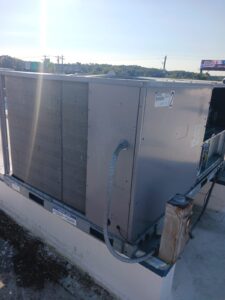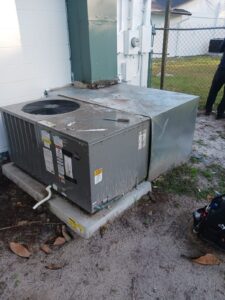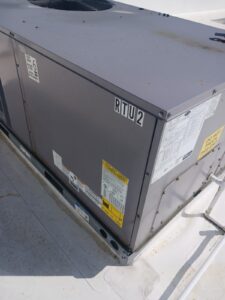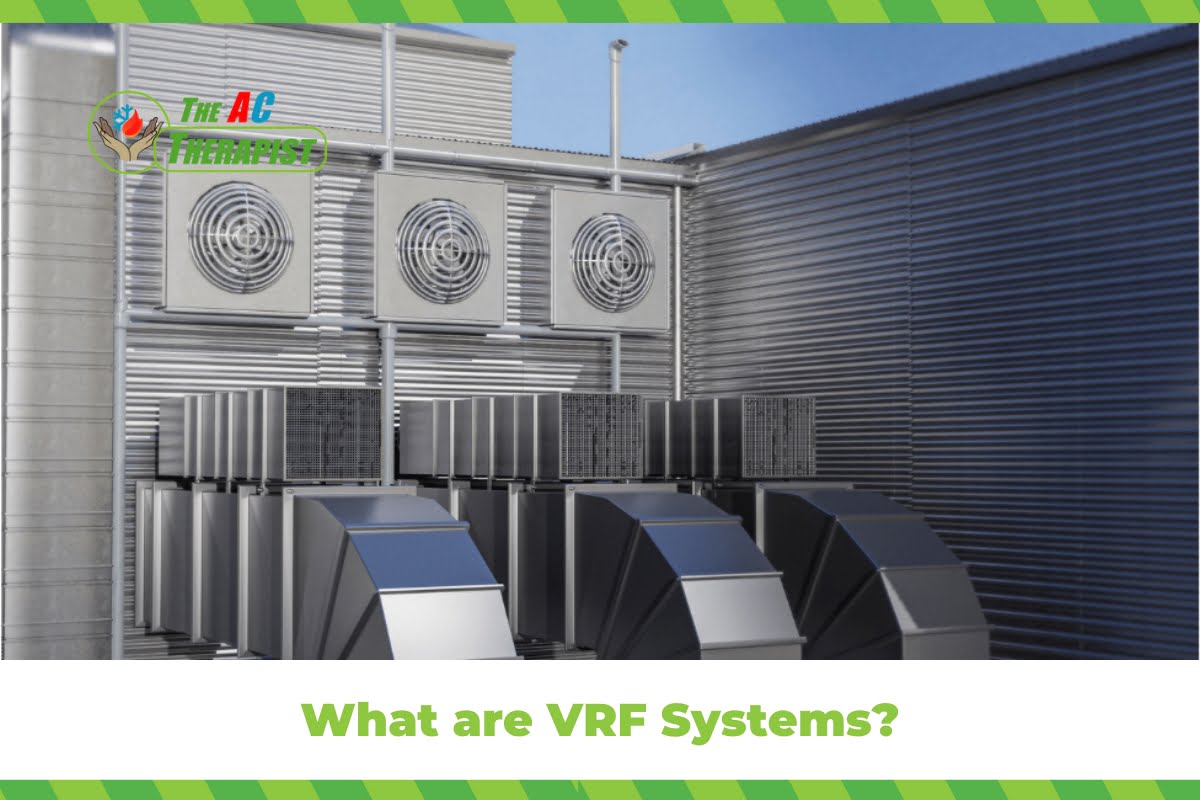What are VRF Systems?
In the quest for more efficient, adaptable, and space-saving heating, ventilation, and air conditioning (HVAC) solutions, Variable Refrigerant Flow (VRF) systems have emerged as a frontrunner in the industry. Tailored to provide precise temperature control, VRF technology has revolutionized the way we approach climate control in residential, commercial, and light industrial settings.
But what exactly is a VRF system, and how does it differ from traditional HVAC setups? This comprehensive guide delves into the mechanics of VRF systems, exploring their components, functionality, and the myriad benefits they offer. Whether you’re a facility manager looking to retrofit an aging building, a homeowner seeking a modern heating and cooling solution, or an HVAC professional staying abreast of the latest trends, understanding VRF systems is crucial in making informed decisions about climate control solutions.
From the bustling commercial hubs to the serene neighborhoods of the Tampa Bay area, VRF systems are gaining traction for their unparalleled efficiency and customization. Join us as we unpack the intricacies of VRF technology and shed light on why it might just be the HVAC solution you’re looking for.
The Basics of VRF Technology
Variable Refrigerant Flow (VRF) technology is a sophisticated HVAC system that has revolutionized the way we think about heating, ventilation, and air conditioning in both residential and commercial spaces. VRF systems are designed to provide precise temperature control by varying the flow of refrigerant to different areas, or “zones,” within a building. This allows for individualized comfort settings and improved energy efficiency. Here’s a closer look at the basics of VRF technology:
Definition of VRF
VRF stands for Variable Refrigerant Flow. This refers to the system’s ability to control the amount of refrigerant flowing to each indoor unit, which in turn, controls the temperature of the space it serves. The technology hinges on a sophisticated network that connects multiple indoor units to a single outdoor unit.
History and Evolution of VRF Systems
VRF technology was developed in Japan during the early 1980s and has since spread globally, gaining popularity due to its efficiency and versatility. Over the years, VRF systems have evolved with advancements in compressor design, inverter technology, and control systems, making them more efficient and adaptable to a wider range of climate conditions and building types.
Components of a VRF System
A typical VRF system consists of the following key components:
Outdoor Units: These are the heart of the VRF system, housing the compressor that circulates the refrigerant. They are designed to be modular, allowing for multiple outdoor units to be connected to increase capacity and flexibility.
Indoor Units: VRF systems can accommodate a variety of indoor unit styles, including wall-mounted, ceiling-mounted, and floor-standing units, among others. Each indoor unit can be controlled independently, allowing for personalized comfort settings in each zone.
Refrigerant Piping: This network of pipes connects the outdoor and indoor units, circulating refrigerant between them. The piping is designed to be as non-intrusive as possible, making VRF systems ideal for retrofitting older buildings where space for ductwork is limited.
Control Systems and Interfaces: VRF systems come with sophisticated control systems that allow for precise temperature management. Users can adjust settings for individual zones through wall-mounted controllers, remote controls, or even smart device applications. Advanced systems can also integrate with building management systems for centralized control.
How VRF Systems Work
VRF systems operate on the basic principles of refrigeration, where the refrigerant absorbs heat from indoor spaces and releases it outdoors, or vice versa for heating. The key to VRF technology is its ability to control the amount of refrigerant flowing to each indoor unit, thanks to:
- Inverter Compressors: These compressors can vary their speed and output to match the cooling or heating demand of the building. By only using the energy necessary to maintain the set temperatures, inverter compressors significantly improve the efficiency of the system.
- Electronic Expansion Valves (EEVs): Located at each indoor unit, EEVs precisely control the flow of refrigerant based on the demand of each zone.
- Zone Control: VRF systems can simultaneously cool some zones while heating others. This is particularly useful in buildings where different rooms have varying exposure to sunlight or occupancy patterns.
Heat Recovery in Integrated Systems
Some VRF systems are equipped with heat recovery capabilities, allowing them to transfer excess heat from zones being cooled to those requiring heat. This feature further enhances the efficiency and comfort provided by VRF technology.

Types of VRF Systems
Variable Refrigerant Flow (VRF) systems have become increasingly popular due to their efficiency and the flexibility they offer in heating and cooling commercial and residential buildings. There are primarily two types of VRF systems: heat pump systems and heat recovery systems. Each type is designed to address specific needs and applications, offering a range of benefits for different settings.
Heat Pump VRF Systems
Heat pump VRF systems are designed to provide either heating or cooling to a building at any given time, making them ideal for regions with distinct heating and cooling seasons or for buildings with uniform thermal loads across zones.
How They Work:
- In cooling mode, the system extracts heat from the indoor air and discharges it outside.
- In heating mode, the process is reversed, and the system extracts heat from the outdoor air and releases it indoors.
- The system cannot provide heating and cooling simultaneously; it can only switch between modes.
Applications:
- Ideal for buildings with consistent room usage patterns, such as single-tenant office buildings or schools.
- Suitable for areas where the climate demands only heating or cooling at one time.
Heat Recovery VRF Systems
Heat recovery VRF systems are more sophisticated and can provide heating and cooling to different areas at the same time. This is particularly useful in buildings where different spaces may have varying heating and cooling needs simultaneously.
How They Work:
- These systems can capture the heat extracted from the cooling process and redirect it to areas that require heating.
- They have a more complex refrigerant circuitry that allows for simultaneous heating and cooling in different zones.
- The ability to recover and redirect heat makes these systems extremely efficient, especially in buildings with diverse and dynamic thermal loads.
Applications:
- Perfect for mixed-use buildings, like hotels or apartment complexes, where individual rooms may have different heating and cooling needs.
- Ideal for buildings with internal heat gains from people or equipment, such as hospitals or data centers, where some rooms need to be cooled while others need to be heated.
Comparison and Use-Case Scenarios
When deciding between a heat pump and a heat recovery VRF system, consider the following:
- Climate: In regions with a predominantly cold or warm climate, a heat pump VRF system might suffice. However, in areas with significant seasonal variations, or in buildings where internal conditions vary greatly, a heat recovery system offers more versatility.
- Building Layout and Usage: Heat recovery systems are typically best for buildings with varying occupancy patterns and diverse thermal load requirements across different zones.
- Energy Efficiency: While both systems are energy-efficient, heat recovery VRF systems can further reduce energy consumption by transferring heat from areas being cooled to those that need heating.
- Cost: Heat pump VRF systems are generally less expensive than heat recovery systems due to their simpler design. However, the energy savings and operational efficiencies of heat recovery systems can offset the initial higher investment over time.

Benefits of VRF Systems
Variable Refrigerant Flow (VRF) systems offer a multitude of benefits over traditional HVAC systems, making them an increasingly popular choice for both new construction and retrofit projects. Here are some of the key advantages of implementing a VRF system:
Energy Efficiency and Environmental Impact
- Precision Control: VRF systems provide precise control over the refrigerant flow, which allows them to deliver the exact amount of cooling or heating needed to each zone. This precision reduces energy waste.
- Inverter Technology: The inverter compressors in VRF systems adjust their speed based on demand. This means they consume only the energy necessary for the current conditions, which can lead to significant energy savings.
- Less Ductwork: Because many VRF systems are ductless, they avoid the energy losses associated with ductwork, particularly when ducts must pass through unconditioned spaces.
- Heat Recovery: VRF systems with heat recovery capabilities can transfer heat from areas being cooled to those that need heating, which can significantly improve energy efficiency.
Customization and Scalability
- Modular Design: The modular nature of VRF systems allows them to be scaled up or down to suit the specific needs of a building. Additional indoor units can be added with minimal disruption.
- Zoning Capabilities: VRF systems can create multiple zones with individual temperature control, providing personalized comfort and avoiding the energy waste of heating or cooling unoccupied spaces.
- Wide Range of Indoor Units: VRF systems offer a variety of indoor unit types and styles to fit different room sizes and uses, from wall-mounted units to ceiling cassettes to concealed ducted units.
Quiet Operation and Space-Saving Design
- Low Noise Levels: VRF systems are known for their quiet operation, both indoors and outdoors. This is due to advanced fan and compressor designs that minimize noise, making them ideal for environments where noise is a concern, such as offices, hospitals, and schools.
- Compact Equipment: The outdoor units are compact and can be placed in areas with limited space, such as rooftops or balconies. The indoor units are also sleek and require less space than traditional HVAC systems.
Superior Comfort and Control
- Consistent Temperatures: The sophisticated technology that drives VRF systems allows for maintaining consistent indoor temperatures, avoiding the temperature fluctuations common with traditional HVAC systems.
- Individual Control: Occupants can control the temperature in their own space without affecting other areas, leading to increased satisfaction and comfort.
- Improved Air Quality: Many VRF systems come with advanced filtration options that improve indoor air quality, which is crucial for health and comfort.
Installation Considerations for VRF Systems
- Faster Installation: VRF systems can be installed more quickly than traditional systems, especially in retrofit situations where existing structures and spaces can be used without extensive modification.
- Less Invasive: The smaller refrigerant lines and lack of ductwork in many VRF systems make them less invasive to install, which is particularly advantageous in historic buildings or where space is at a premium.
Maintenance and Longevity
- Ease of Maintenance: With fewer mechanical components and advanced diagnostic tools, VRF systems are often easier and less costly to maintain than traditional systems.
- Longevity: The reduced mechanical stress on VRF system components, due to the variable-speed compressors and fans, can lead to a longer operational life.
Cost-Benefit Analysis
While the initial cost of a VRF system may be higher than traditional HVAC systems, the long-term savings on energy bills, maintenance, and potential rebates can make VRF a cost-effective solution over the lifespan of the system.

Common Misconceptions About VRF Systems
Variable Refrigerant Flow (VRF) systems, while increasingly popular, are still subject to several misconceptions. These misunderstandings can lead to hesitation or misuse of the technology, preventing users from fully benefiting from its potential. Let’s address some of the common myths about VRF systems:
Misconception 1: VRF Is Only for Large Buildings
Reality: VRF systems are highly scalable and modular, making them suitable for buildings of all sizes. While they are indeed a popular choice for large commercial buildings due to their efficiency in managing diverse and fluctuating heating and cooling loads, they can also be an excellent choice for smaller commercial spaces and even residential applications. The key is proper system design to match the specific needs of the space.
Misconception 2: VRF Systems Are Too Expensive
Reality: The initial cost of a VRF system can be higher than traditional HVAC systems, but this is only part of the financial picture. VRF systems often lead to lower operational costs due to their energy efficiency, which can result in significant savings over the life of the system. Additionally, the potential for lower maintenance costs and utility rebates can further offset the initial investment.
Misconception 3: VRF Can’t Be Used in Extreme Climates
Reality: Modern VRF systems are designed to operate efficiently across a wide range of temperatures and can be used in both very cold and very hot climates. Advances in compressor and refrigerant technology have expanded the operational range of VRF systems, making them a viable option even in extreme conditions.
Misconception 4: VRF Systems Are Difficult to Install
Reality: VRF systems can be easier and faster to install than traditional systems, especially in retrofit situations. The modular design, smaller piping, and less invasive infrastructure requirements make installation less cumbersome. However, installation must be carried out by professionals with experience in VRF technology to ensure optimal performance.
Misconception 5: VRF Systems Are Noisy
Reality: One of the advantages of VRF systems is their quiet operation. The indoor units are typically very quiet, and while the outdoor units may generate some noise, it is generally less than or comparable to traditional HVAC systems. Proper placement and installation can further mitigate any noise concerns.
Misconception 6: VRF and VRV Are Different
Reality: Variable Refrigerant Volume (VRV) is a term coined by Daikin Industries, Ltd., to describe their version of VRF technology. Essentially, VRV and VRF are the same technology and operate on the same principles. The terms are often used interchangeably outside of branding contexts.
Misconception 7: VRF Systems Don’t Provide Fresh Air
Reality: While VRF systems are primarily designed for heating and cooling, they can be integrated with ventilation systems to ensure a fresh air supply. It’s a matter of system design to include ventilation by building codes and indoor air quality standards.
Misconception 8: Maintenance Is a Hassle
Reality: VRF systems are designed with advanced diagnostics and are generally considered easier to maintain than traditional systems. Regular maintenance is still important, as with any HVAC system, but the overall burden is often reduced due to the system’s design and the diagnostic tools available.
Misconception 9: VRF Is Not Energy Efficient for Heating
Reality: VRF systems can be highly efficient for heating, especially those equipped with heat recovery technology. They can extract heat from the outdoor air even in cold conditions and use it to heat indoor spaces efficiently.
By addressing these misconceptions, potential users can make more informed decisions about whether VRF technology is suitable for their specific needs. It’s important to consult with HVAC professionals who can provide accurate information and guidance based on the latest technology and industry standards.
Maximizing Comfort and Efficiency: The AC Therapist’s Guide to VRF Systems
In conclusion, Variable Refrigerant Flow (VRF) systems represent a significant advancement in the realm of HVAC solutions, offering unparalleled efficiency, adaptability, and control. These systems are designed to meet the diverse needs of modern buildings, providing personalized comfort while minimizing energy consumption and operational costs. With their ability to precisely match the cooling and heating demands of each zone, VRF systems not only enhance the comfort of occupants but also contribute to the sustainability goals of a building by reducing its carbon footprint.
The scalability of VRF technology makes it suitable for a wide range of applications, from small residential projects to large commercial ventures. Moreover, the integration of advanced inverter compressors and heat recovery functions allows these systems to operate with remarkable efficiency in various climates, debunking the myth that they are only suitable for moderate temperature zones.
While the initial investment in a VRF system may be higher than traditional HVAC systems, the long-term savings, both in energy costs and maintenance, can be substantial. It is essential, however, to ensure that the system is correctly designed and installed by professionals to maximize these benefits.
For those in the Tampa Bay area, The AC Therapist stands ready to provide expert guidance and services in the realm of VRF systems. Whether you are considering a VRF system for a new construction project or looking to retrofit an existing building, The AC Therapist can help you navigate the complexities of VRF technology to find the most efficient and cost-effective solution for your needs. With a deep understanding of VRF systems and a commitment to excellence, The AC Therapist is your partner in achieving optimal indoor comfort and energy efficiency.








